|
|
A
Close-up View of the Wildflower (Leonurus cardiaca) |
|
|
A
Close-up View of the Wildflower (Leonurus cardiaca) |
Motherwort
grows in the shade of a row of Black Locust trees near where I
live. My plan over the summer was to record the life cycle of
this strange plant with a view to writing an article for
Micscape. Imagine my horror when, for the first time in many
years, the city decided to enhance the appearance of municipal areas by
frequent “weed-whacking” of all non-grassy areas!
I needn't have worried. In his 1977 book about weeds, Lawrence J.
Crockett describes them as “wildly successful plants”. How
true! Every time the plants were cut off at ground level, within
a week, new sprouts had begun to sprout and shortly thereafter, I had
fresh, new plants to photograph.
As you can see above, Motherwort is not a typical looking
wildflower. Careless handling can result in painful punctures
produced by the sharp spines that can be seen beneath the flower.
The plant is a member of the Mint family, as are such common plants as
basil, mint, oregano and sage. The genus name Leonurus derives
from the Greek words leon, meaning “lion” and oura meaning
“tail”. A mature plant has many white, fuzzy hairs associated
with the blooms and this fact probably suggested the name. The
species name cardiaca
is based upon its use by herbalists for heart problems.
Historically, a tea made from the plant was used to treat mothers
during childbirth and this resulted in the common name Motherwort.
A mature plant is shown below. Although Motherwort commonly grows
as high as 1.5 metres, my subjects were an average of 25 centimetres in
height. Notice the distinctively shaped leaves and the large
number of pink flowers.

Some plants seem to be hairier than others. The one below is a
good example.

Numerous small green buds surround the topmost part of the growing
plant.

In contrast to an earlier example, this plant is relatively
hairless. It is therefore much easier to see the rings of spikes
that occur at the points where leaf stalks meet the stem (the leaf axils). Positioning one’s
fingers in such a way that the plant can be grasped painlessly, is
difficult.

The spiked “collar” is actually formed by a ring of tubular green
calyxes which surround immature flowers and remain after the flowers
shrivel up and fall off. (A calyx
is a ring of modified leaves, called sepals,
that grow immediately under the petals of a flower.)
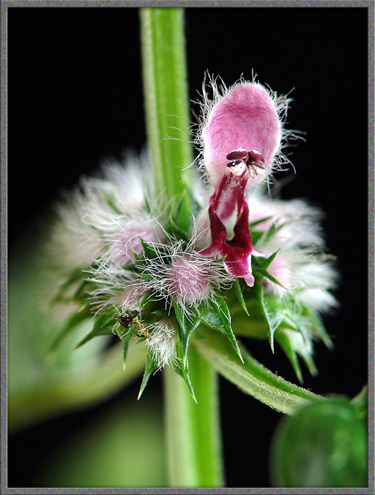
The Motherwort flower has five petals (which form the corolla), two of which form the pink
hairy hood, or upper lip. In this plant it is not possible to
distinguish the two, and only a single lobe is visible. The other
three petals form the darker red, three lobed lower lip. These
petals are fused together further into the tube. There are 4 anthers (male, pollen producing
structures) in two pairs: an upper and a lower. The single
stigma (female, pollen accepting structure) is positioned between the
top pair of anthers but is not visible in the photograph.
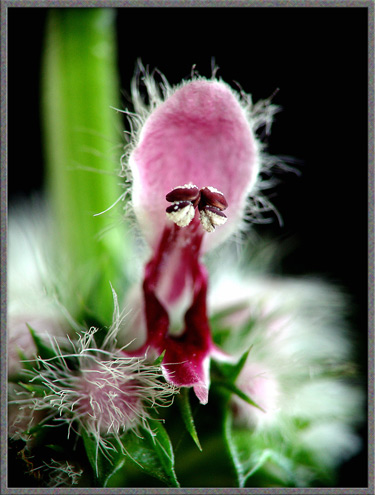
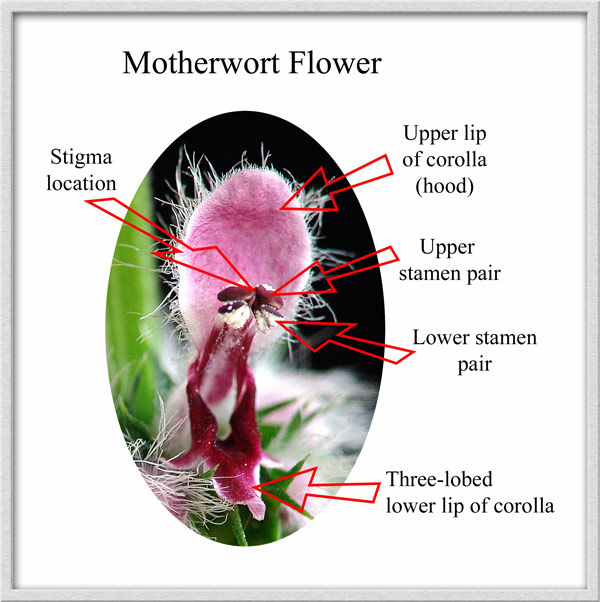
Under the microscope the stigma can be seen to possess two lobes, one
of which has several pollen grains clinging to it. The two dark
red stalks are the filaments
to which anthers are attached.
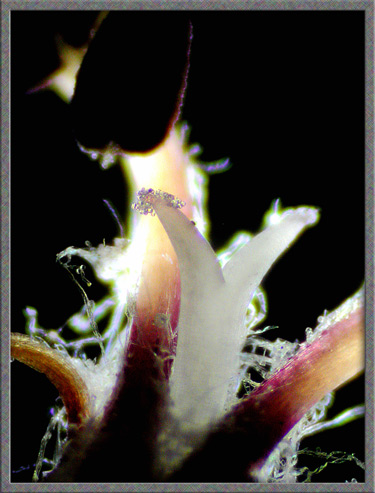
The surface of one of the four anthers can be seen in the image
below. Several groups of colourless spherical pollen grains are
present, as is a single white hair which has become detached from the
flower.

Another view of an anther shows its rough surface.

A higher magnification photomicrograph of one of the white hairs shows
the unusual “join” in the stalk.

When the Motherwort plant first appears in the Spring, it forms a
rosette (flattened spiral arrangement) of bright green leaves.

Later, the mature plant displays the distinctively shaped leaves that
can be seen below.

Both upper and lower surfaces of these leaves are covered with very
tiny short hairs.


Once a flower has been fertilized, it falls off leaving the green calyx
with its five spikes. As can be seen below, each calyx has two
distinctive grooves which form a cross or X shape. These grooves
form the outline of the four developing fruit, called nutlets. At a slightly earlier
stage, these grooves are obscured by a tuft of white hairs.


As time progresses, the calyxes begin to dry out and take on a brown
colouration.
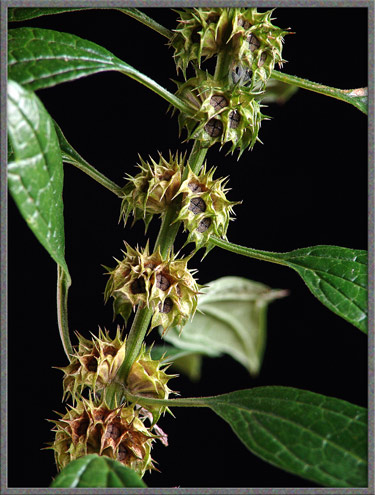
The stem of a Motherwort plant is very strong and square in
cross-section. There are numerous longitudinal ridges on its
surface.
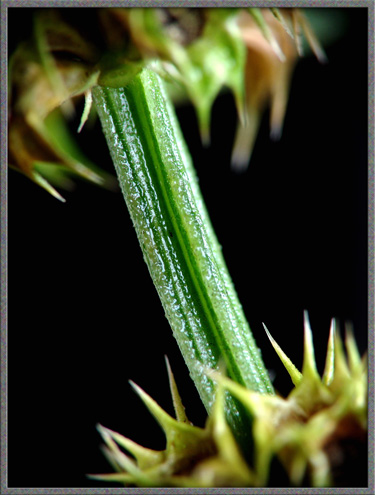
Using a higher magnification the details of a single immature calyx are
revealed. Note the five spikes, three forming a cross at the top
and two which curve downward.
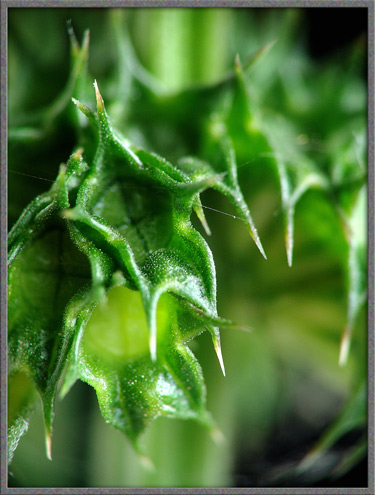
A little later the developing nutlets have begun to turn dark brown.
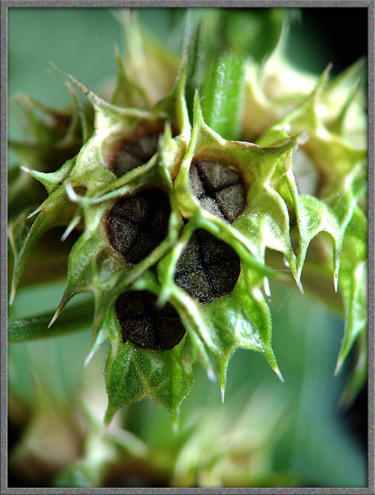
Much later, the material of the calyx has become translucent and
appears light brown. Eventually, the structure of the calyx
begins to break down, dislodging the four nutlets and allowing them to
fall to the ground.
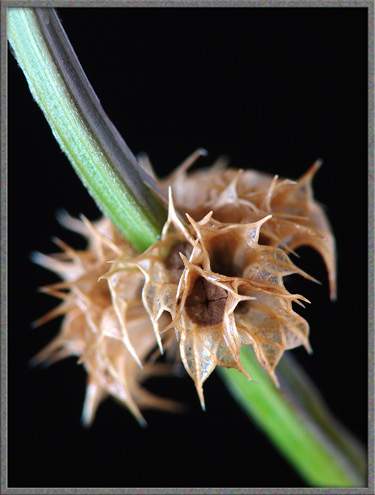
Motherwort is an example of a wildflower that doesn’t overtly display
its charms, and is therefore often relegated to the “noxious weed”
category. On closer inspection however, its unusual flowers are
quite striking, and well worth some study.
Photographic Equipment
The photographs in the article were taken with an eight megapixel Sony
CyberShot DSC-F 828 equipped with achromatic close-up lenses (Nikon 5T,
6T, Sony VCL-M3358, and shorter focal length achromat) used singly or
in combination. The lenses screw into the 58 mm filter threads of the
camera lens. (These produce a magnification of from 0.5X to 10X
for a 4x6 inch image.) Still higher magnifications were obtained
by using a macro coupler (which has two male threads) to attach a reversed 50 mm focal length f 1.4
Olympus SLR lens to the F 828. (The magnification here is about
14X for a 4x6 inch image.) The photomicrographs were taken with a Leitz
SM-Pol microscope (using a dark ground condenser), and the Coolpix
4500.
References
The following references have been
found to be valuable in the identification of wildflowers, and they are
also a good source of information about them.
Published in the
November 2005 edition of Micscape.
Please report any Web problems or
offer general comments to the Micscape
Editor.
Micscape is the on-line monthly magazine
of the Microscopy UK web
site at Microscopy-UK
© Onview.net Ltd, Microscopy-UK, and all contributors 1996 onwards. All rights reserved. Main site is at www.microscopy-uk.org.uk with full mirror at www.microscopy-uk.net .